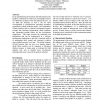Free Online Productivity Tools
i2Speak
i2Symbol
i2OCR
iTex2Img
iWeb2Print
iWeb2Shot
i2Type
iPdf2Split
iPdf2Merge
i2Bopomofo
i2Arabic
i2Style
i2Image
i2PDF
iLatex2Rtf
Sci2ools
METRICS
1998
IEEE
1998
IEEE
Getting a Handle on the Fault Injection Process: Validation of Measurement Tools
In any manufacturing environment, the fault injection rate might be considered one of the most meaningful criterion to evaluate the goodness of the development process. In our field, the estimates of such a rate are often oversimplified or misunderstood generating unrealistic expectations on their prediction power. The computation of fault injection rates in software development requires accurate and consistent measurement, which translates into demanding parallel efforts for the development organization. This paper presents the techniques and mechanisms that can be implemented in a software development organization to provide a consistent method of anticipating fault content and structural evolution across multiple projects over time. The initial estimates of fault insertion rates can serve as a baseline against which future projects can be compared to determine whether progress is being made in reducing the fault insertion rate, and to identify those development techniques that seem...
Development Organization | Fault Injection Rates | Fault Insertion Rate | METRICS 1998 | Software Engineering |
| Added | 05 Aug 2010 |
| Updated | 05 Aug 2010 |
| Type | Conference |
| Year | 1998 |
| Where | METRICS |
| Authors | Sebastian G. Elbaum, John C. Munson |
Comments (0)

